
  |
NORMAL
Brown to grayish-tan color and slight electrode wear. Correct heat range for engine and operating conditions. When new spark plugs are installed, replace with plugs of the same heat range. |
||||||||||||||
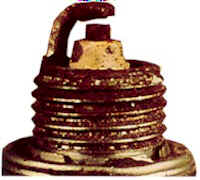 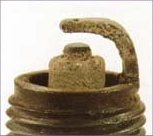 |
WORN
Rounded electrodes with a small amount of deposits on the firing end. Normal color. Causes hard starting in damp or cold weather and poor fuel economy. The voltage required to fire the plug has approximately doubled and will continue to increase with additional miles of travel. Even higher voltage requirements, as much as 100% above normal, may occur when the engine is quickly accelerated. Poor engine performance and a loss in fuel economy are traits of a worn spark. |
||||||||||||||
|
DEPOSITS
|
||||||||||||||
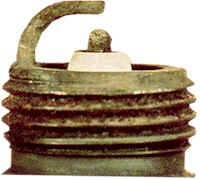 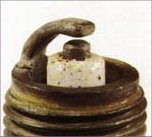 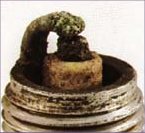 |
OVERHEATING
Blistered, white insulator, eroded electrode and absence of deposits. Results in shortened plug life. This is often caused by over advanced ignition, timing, poor engine cooling system efficiency (scale, stoppages, low level), a very lean air/fuel mixture, or a leaking intake manifold. When these conditions prevail, even a plug of the correct heat range will overheat. Melting may also occur. Usually, the electrode surface is rather lustrous and uneven. Nickel alloys melt at between 2200 and 2400 deg.F. |
||||||||||||||
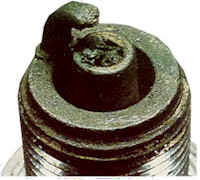 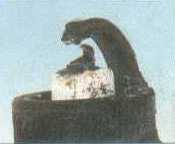 |
PREIGNITION
Melted electrodes. Insulators are white, but may be dirty due to misfiring or flying debris in the combustion chamber. Can lead to engine damage. Check for the correct plug heat range, over advanced timing ignition, lean fuel mixture, insufficient engine cooling and lack of lubrication. Usually one or a combination of several engine operating conditions are the prime causes of pre-ignition. It may originate from glowing combustion chamber deposits, hot spots in the combustion chamber due to poor control of engine heat, cross-firing (electrical induction between spark plug wires), or the plug heat range is too high for the engine or its operating conditions. |
||||||||||||||
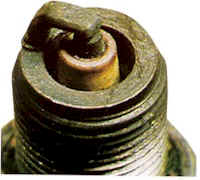 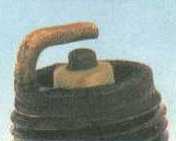 |
INSULATOR GLAZING
Insulator has yellowish, glazed appearance. Indicates that combustion chamber temperatures have risen suddenly during hard acceleration. Normal deposits melt to form a conductive coating which can causes misfiring at high speeds. Install new plugs. Consider using a colder plug is driving habits warrant. |
||||||||||||||
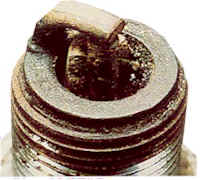 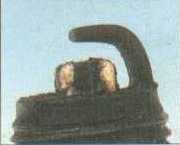 |
DETONATION
Insulators may be cracked or chipped. Improper gap setting techniques can also result in a fractured insulator tip. Can lead to piston damage. The explosion that occurs in this situation apples extreme pressures on internal engine components. Prime causes include ignition time advanced too far, lean air/fuel mixtures, and insufficient octane rating of the gasoline. Make sure the fuel antiknock values meet engine requirements. Use care when setting the gaps on new plugs. Avoid lugging the engine. |
||||||||||||||
|
EROSION,CORROSION,OXIDATION | ||||||||||||||
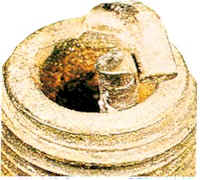 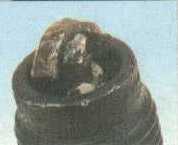 |
MECHANICAL DAMAGE
May be caused by a foreign object in the combustion chamber or the piston striking an incorrect reach (too long) plug. Causes a dead cylinder and could result in piston damage. Repair the mechanical damage. Remove the foreign object from the engine and/or install the correct reach plug. When this condition is discovered, check the other cylinders to prevent a recurrence, since it is possible for a small object to "travel" from one cylinder to another where a large degree of valve overlap exists. |
| GENERAL INFO: | ||||
| Normal:
Grey to Light Golden-Brown Color This condition is ideal, the spark plug and engine air/fuel mixture are operating properly. |
Dry:
Black Soot Buildup
|
Wet Fouling:
Shiny, Wet, Black Appearance
|
Excess Deposits:
Bumpy, Chalky Buildup
|
Overheated:
White, Blistered, Melted Electrode
|
| NOTE:
A detonation problem would show signs, such as silver specs, black specs, or melting or breakage at the firing tip. Signs of fouling or excessive heat must be traced quickly to prevent further deterioration of performance and to prevent possible engine damage. |
||||
|
Web site design by Saftek. Copyright © , Saftek Inc. Duplication of any element of this
Not affiliated with Kawasaki. Kawasaki, Vulcan and Drifter are trademarks of Kawasaki. |